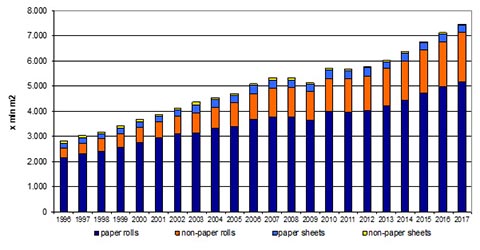Sophisticated Substrates Lead the Charge in Label Sector Growth
Press release from the issuing company
The Hague, The Netherlands – Sophisticated label substrates have experienced exponential growth due to demand for high-end applications according FINAT’s latest findings.
Since 2010 demand for PP-based materials has grown 78%, direct thermal papers are up 51% and white coated papers enjoyed a 24% increase. The figures show that while paper based materials continue to dominate label materials demand, there has been a shift from basic primary and VIP labels towards more sophisticated, high-end applications.
Jules Lejeune, FINAT Managing Director, comments: “The continued growth in demand for packaged consumer goods, especially in emerging economies, has increased the need for white, coated materials as end-users are looking to differentiate their branded products on the shelf. Labels containing variable product data in sectors like retail, logistics, process automation and inventory management demand an ever growing volume of direct thermal papers. But above all, the need for high quality (transparent) product decoration in high speed, high volumes sectors like food, health and beauty care and premium beverages is driving the surge in the consumption of PP-based labels.”
The trend is encouraging self-adhesive label producers to offer adjacent high-end packaging solutions like pouches, sleeves and other flexible packaging items. They are also investing in the corresponding knowledge, facilities and accreditation programmes like in the case of food safety.
These findings are based on the backdrop of a 4.7% European growth rate in total consumption of self-adhesive label materials, up to 7.45 million m2 in 2017, slightly below the 5.4% average over the preceding four years.
Eastern Europe Drives Growth
The continued evolution of Eastern European markets also remains a key growth driver and has helped European label companies on aggregate record an increase of almost 1.7 billion m2 in their annual demand since 2010.
Geographically, established markets Germany, UK, Italy, France and Spain, still account for 58% of the total European market size with emerging Poland and Turkey catching up. They are expected to challenge the top five in the next few years.
There are, however, significant European disparities when comparing demand in terms of consumption per capita. While the European average of 9.7 m2 is approaching the 10 m2 benchmark, Denmark, Lithuania and The Netherlands (all small, export oriented countries) consumed almost 17.5 m2 per capita. The bottom 10 countries recorded consumption less than 5 m2 per capita.
Among these are Romania, Russia and Turkey, between them representing almost 250 million inhabitants or one-fifth of the total population in the countries under review. This indicates there is still a huge potential for future structural growth. This potential does not consider the continuously widening scope of the labels sector into short term flexible packaging.
Short term outlook: signs of economic slowdown?
There is a clear statistical correlation between roll labelstock demand and the general economic climate according to FINAT’s statistical agency Panteia. Unsurprising is the fact that labels are an essential enabler in a wide variety of sectors of the business community. Looking back, general economic cycle change in the EU28 countries over the past 15 years was ‘announced’ by a reversal of labelstock demand in the previous quarters.
Lejeune states: “Given the present uncertainties associated with Brexit, escalating trade wars between the EU and the US, continued trade sanctions against Russia and, finally, re-emerging concerns about the euro following the installation of the new Italian government, it should come as no surprise that the gap between annualised growth rates in the label industry and GDP has been shrinking in recent quarters after five years of continued well above GPP growth rates.”
RADAR Signals Buoyant Markets
FINAT’s other market research partners, LPC Inc. completed technical surveys and one-on-one interviews with brands across Europe for the spring 2018 edition of FINAT RADAR. It confirms the buoyant state of the label industry. Average annual sales growth over the past five years was 7.1%, although this slowed in 2017 compared to previous years. Interestingly the highest growth rates were recorded in non-prime markets like automotive, consumer durables and industrial chemicals while the largest labelling sectors of food and beverages continue to be among the top five growth markets.
It gives FINAT members a unique perspective on the European labelling sector, and on the trends and forces that are driving brands to adopt and implement specific labelling technologies and decoration formats. Two trends dominate: prime labels are becoming increasingly complex and non-prime labels are becoming increasingly functional.
The Eurozone economy’s robust performance thanks to a recovering labour market and healthy external demand supports ongoing label sector growth. As a result, brands are persistently seeking ways to connect with their customers. One method is through package decoration. As brands strive to achieve a market-specific approach late in the supply chain they require shorter runs and fast turnaround to accommodate late-stage design and label functionality requirements. This is driving digital press adoption and shapes how marketing and R&D departments create consumer captivating campaigns.
Lejeune concludes: “The future remains bright for labels. When asked which printed packaging sector delivers the most innovation, again and again brands claim their label suppliers offer more innovation and agility over their flexible packaging, carton and corrugated suppliers.”

European Label Industry
- Questions to ask about inkjet for corrugated packaging
- Can Chinese OEMs challenge Western manufacturers?
- The #1 Question When Selling Inkjet
- Integrator perspective on Konica Minolta printheads
- Surfing the Waves of Inkjet
- Kyocera Nixka talks inkjet integration trends
- B2B Customer Tours
- Keeping Inkjet Tickled Pink
© 2024 WhatTheyThink. All Rights Reserved.














